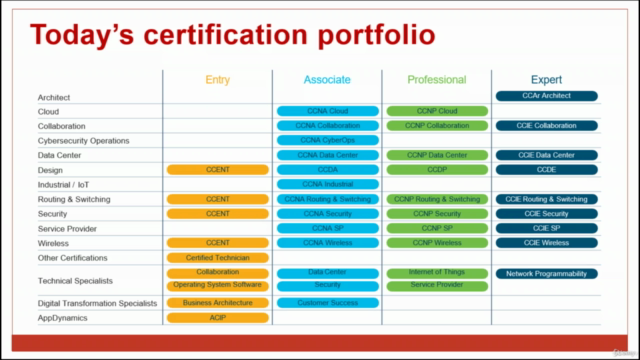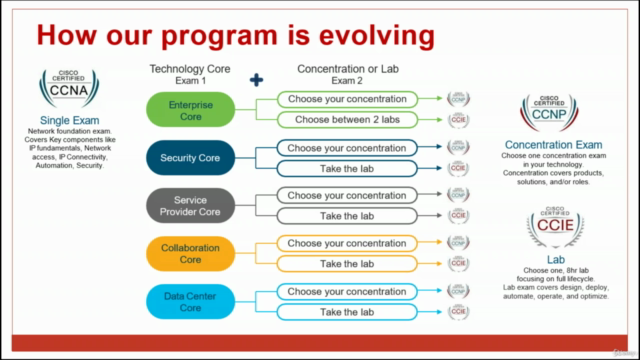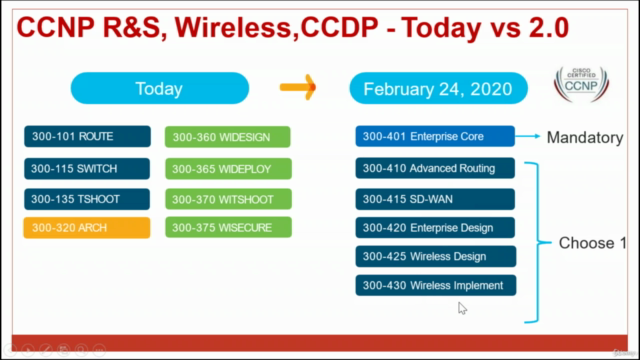Cisco CCNP Enterprise - 350-401-ENCOR - FastTrack

Why take this course?
-
Routing and Switching Fundamentals (25%):
- 1.2 Configure and verify router-on-a-stick for EtherChannel interfaces using Cisco IOS or NX-OS.
- 1.3 Configure and verify VLANs, DTP, and STP (both RSTP and MSTP) on switches.
- 1.4 Implement and verify Quality of Service (QoS) on Cisco devices for voice, video, and data traffic.
- 1.5 Configure and verify interVLAN routing using either VLAN-aware routers or Layer 3 switches.
-
Infrastructure Security (10%):
- 2.2 Describe the components of a Cisco secure infrastructure, including firewalls, ISE, ASA, and TrustSec.
- 2.3 Configure and verify security zones and interfaces on a Cisco Nexus switch or router.
- 2.4 Configure and verify a ZTP/DFS (Zero Trust and Device Hardening Services) deployment in a campus network.
-
Network Programmability (10%):
- 3.1 Describe the concepts of network programmability, including NETCONF, RESTCONF, and YANG models.
- 3.2 Configure and verify device configuration using YANG models with Pyratax or similar tools.
- 3.3 Write Python scripts to interact with Cisco devices using PyEZ or Paramiko for automation purposes.
-
Multicast and Advanced Routing Protocols (10%):
- 4.1 Configure and verify PIM and MVPN (Virtual Private LAN Service) on a multicast-enabled network.
- 4.2 Describe the use of BGP with Multiprotocol Label Switching (MPLS) in service provider networks.
- 4.3 Explain and configure High-availability protocols like VRRP, HSRP, or GLBP on a Cisco switch or router.
-
Network Assurance and Troubleshooting (10%):
- 5.1 Configure and verify SPAN, RSPAN, and ERSPAN to troubleshoot network issues.
- 5.2 Use NXOS show and clear commands to troubleshoot network performance and issues.
- 5.3 Describe how to use Cisco DNA Center for network assurance.
-
Advanced Services (10%):
- 6.1 Configure and verify NAT/PAT using either NX-OS or IOS.
- 6.2 Implement Network Time Protocol (NTP) on Cisco devices and ensure time synchronization across the network.
- 6.3 Configure and verify HSRP, VRRP, or GLBP for high availability on a network.
-
Collaboration (5%):
- 7.1 Describe and configure Cisco Unified Communications Manager (CallManager) features to support enterprise voice communication.
- 7.2 Configure and verify quality of service for VoIP traffic on the network.
-
Data Center Technologies (10%):
- 8.1 Configure and verify a Cisco Nexus switch for data center technologies such as Fibre Channel over Ethernet (FCoE), Data Center Bridging (DCB), or NVGRE/VXLAN for virtualized networks.
- 8.2 Describe the deployment and configuration of NFS or iSCSI storage solutions in a data center environment.
-
Wireless LAN (10%):
- 9.3 Configure and verify secure mobility using 802.1X authentication between access points and wired infrastructure.
- 9.4 Troubleshoot WLAN configuration and wireless client connectivity issues, including RF propagation and interference issues.
- 9.5 Describe the principles of Location-Based Services (LBS) in a WiFi network using Cisco technology.
-
IP Services (5%):
- 10.2 Configure and verify DHCP failover between two servers for high availability.
- 10.3 Implement and configure IPv6 on all devices in the network, including configuration of dual-stack.
-
Security Fundamentals (5%):
- 11.1 Configure and verify AAA (Authentication, Authorization, and Accounting) using RADIUS or TACACS+ on Cisco devices.
- 11.2 Describe the steps to implement a basic firewall policy on a Cisco device using Access Control Lists (ACLs).
-
Automation and Orchestration (5%):
- 12.1 Describe the use of APIs in network automation and configuration management.
- 12.2 Configure and verify an orchestration solution that uses Cisco DNA Center, Ansible, or similar tools for network provisioning.
- 12.3 Compare and contrast agent-based versus agentless infrastructure management platforms.
To pass the CCIE R&S lab exam, you will need to have a deep understanding of networking concepts, hands-on experience with Cisco devices and software, and the ability to design, implement, and troubleshoot complex network architectures. It's also important to stay updated with the latest Cisco technologies and updates in the study materials, as the exam content evolves over time.
Course Gallery




Loading charts...